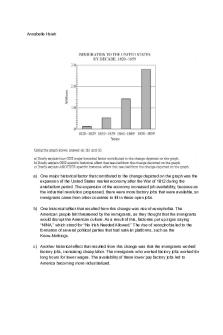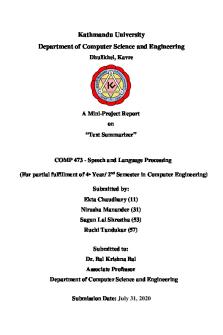Australian Immigration Companion - (Chapter 1 Using This Text) PDF

| Title | Australian Immigration Companion - (Chapter 1 Using This Text) |
|---|---|
| Author | Hawra Masoud |
| Course | Migration and Refugee Law and Policy |
| Institution | Deakin University |
| Pages | 18 |
| File Size | 373.1 KB |
| File Type | |
| Total Downloads | 100 |
| Total Views | 143 |
Summary
Australian Immigration Companion - (Chapter 1 Using This Text) FOR MIGRATION AND REFUGEE LAW AND POLICY...
Description
Chapter1
Using This Text Introduction 1.1 Anyone
studying or practising Australian migration law will quickly realise
that this area of law is extremely complex and highly prescriptive. Failure to satisfy a criterion can mean that a client will not obtain his or her desired visa or migration objective, or depending on the circumstances it will result in an application being determined as invalid. This
textbook
has
been
developed
to
assist
migration
practitioners
—
students, academics, lawyers, migration agents, staff of the Department of Home Affairs, parliamentarians’ staff, or anyone with an interest in migration law — to understand Australian migration law in a practical and real-life context. The book will be an invaluable companion for students studying the entry-level Graduate Diploma course prescribed by the Minister for Immigration, Citizenship and Multicultural Affairs. However, we also believe that practising migration agents, and newly registered lawyers, will find it a useful aid in their work and professional
Copyright © 2021. LexisNexis Butterworths. All rights reserved.
development. Immigration officers in Australia and overseas might also use this book for training purposes, information exchange and discussion. We hope you enjoy and learn from this and excuse any errors or omissions. The book is designed for general information only, and it should not be relied upon for the purpose of any particular case or application. Feedback from readers would be welcome. Your comments and suggestions will help us to improve the quality and relevance of the book. Please note that the scenarios and suggested answers, while current at the time of publication, may become less so as new laws are passed or new interpretations are made. The book is structured as follows: Chapter 1 — How to use this text Chapter 2 — A set of questions based on scenarios classified by topic Chapter 3 — Suggested answers to the questions
1 Fernandez, Rodger, et al. Australian Immigration Companion, LexisNexis Butterworths, 2021. ProQuest Ebook Central, http://ebookcentral.proquest.com/lib/deakin/detail.action?docID=6564210. Created from deakin on 2022-02-13 15:56:29.
1.2
Australian Immigration Companion
Suggested approach to using this text 1.2 The
following table guides you through the recommended steps to utilise
this book most effectively and efficiently.
Table 1.1: Approach to using this text
Before you start
Ensure you have access to either a hard or soft copy of the essential migration legislation: the Migration Act1958 and Migration Regulations 1994. It will also be necessary to have internet access so you can search LEGENDcom and the Federal Register of Legislation at. Use the classification references to select specific topics in Chapter2 for analysis. Read the scenario carefully, noting the key facts of the case.
Copyright © 2021. LexisNexis Butterworths. All rights reserved.
Step 1
Study the legislation to determine all the requirements for the visa subclass(es). Refer to actual legislation and not a general textbook which may not be up-to-date and cannot contain all the regulatory requirements. It is also worthwhile examining the relevant policy (especially where it is consistent with that regulatory framework). Ascertain the most appropriate visa subclass(es) and/or any issues raised by the scenario.
Step 2
Prepare answers for each question in the scenario. To maximise benefit from this text, we encourage you to think through the problems independently — without examining the suggested solutions. Compare your solution with the suggested answer in Chapter3.
Step 3
Step 4
Refer to the identified key provisions in the legislation to ensure that you understand how the suggested answer has been derived and how the specific requirements function in the legislation. If you are unsure, repeat the steps and/or seek assistance from your tutor, mentor or a colleague, or consult a basic migration textbook. 2
Fernandez, Rodger, et al. Australian Immigration Companion, LexisNexis Butterworths, 2021. ProQuest Ebook Central, http://ebookcentral.proquest.com/lib/deakin/detail.action?docID=6564210. Created from deakin on 2022-02-13 15:56:29.
Chapter1 Using This Text
1.6
Advice on approaching migration scenario questions 1.3 There
are
many
ways
in
which
to
approach
answering
questions
and
addressing issues in immigration matters. You should also bear in mind your target audience. A different approach will be adopted depending on whether you are answering a question for a client or addressing an issue at the Administrative Appeals Tribunal. Our suggested process below is but one of several approaches. Until you develop your own approach we suggest you start with this one.
1. Carefully read the facts in the scenario to determine relevancy 1.4 Some
of
the
facts
may
be
relevant
whilst
others
may
be
irrelevant
(or distractors).
2. Identify and consider the issues raised in the scenario 1.5 By identifying issues you may be in a better position to answer the questions raised. Think about what other information you need or questions that you would ask the client. Prepare a list.
3. Look out for changing details, important dates andtiming issues Copyright © 2021. LexisNexis Butterworths. All rights reserved.
1.6 Watch
out for frequently changing details. New regulations coming into
force may affect existing as well as new applications. For example, new laws affecting time of decision issues may affect applications submitted before the new laws took effect. Be alert to visa expiry, time limits to respond and the dates of changes in the law, etc. For
example,
changes
in
the
skilled
category
could
be
many,
including:
adding/removing an occupation on the Medium and Long-term Strategic Skills List (MLTSSL) and/or the Short-term Skilled Occupation List (STSOL); changes to the pass mark; or changes in points available to particular components such as English language proficiency. Calculate how many days have passed since an event occurred or before a right may end:
�
if the person is unlawful, or about to become unlawful and still holds a substantive visa;
�
if a visa application has been refused and there are time limits for review, etc.
3 Fernandez, Rodger, et al. Australian Immigration Companion, LexisNexis Butterworths, 2021. ProQuest Ebook Central, http://ebookcentral.proquest.com/lib/deakin/detail.action?docID=6564210. Created from deakin on 2022-02-13 15:56:29.
1.7
Australian Immigration Companion
4. Make sure you know what the question is asking 1.7 There is no use giving a technically correct answer if it does not provide the information, address the issue or provide the opinion required by the question.
5. Prepare your response 1.8 As
the scenarios are focused on preparing students for future practice, they
will often state ‘Advise the client’. Imagine the client is sitting in front of you and explain to them their circumstances, options and the process, fees (including the visa application charge (VAC) and any surcharges) and probable timelines including visa processing timelines. You need to be aware that sometimes there is more than one visa option and you should advise the client about the range of visa options and the most suitable option in the client’s circumstances.
6. Quote/cite the legislation or case as a source/ justification for your answer 1.9 You
should support your answer with relevant legislative references. You
also need to explain why the provision is relevant and how it applies to the issue at hand. Ensure that you indicate whether you are citing the Act, Regulations, or a legislative instrument, etc.
7. Review your answer 1.10 Check
over your answer to ensure you have not missed any issues and
that your spelling, grammar, English expression and citation reinforce the quality
Copyright © 2021. LexisNexis Butterworths. All rights reserved.
of your answer. Ensure that your answer is concise and clear and addresses the issues raised by the question.
4 Fernandez, Rodger, et al. Australian Immigration Companion, LexisNexis Butterworths, 2021. ProQuest Ebook Central, http://ebookcentral.proquest.com/lib/deakin/detail.action?docID=6564210. Created from deakin on 2022-02-13 15:56:29.
Chapter1 Using This Text
1.14
Advice on interpreting terms in legislation 1.11 Whilst there are no set ways to go about the complex process of interpreting terms in legislation, it is wise to develop a methodology for researching the full meaning of defined terms. The following steps may be useful.
1. Study the interpretation provisions in the Migration Act and Regulations 1.12 Having identified the particular legal provisions that are appropriate to your client’s application, you then need to understand their application to your client’s circumstances. For certainty in understanding the meaning of a particular word in the Act or Regulations, you should first look to see if it has been given a definition. If it has, then whatever your previous understanding of the term may have been (either from common sense or a dictionary meaning), this should be updated to reflect the specific legislative intention. Usually this definition is binding. Keep in mind, however, that even if a term has a defined meaning, that meaning may not apply throughout the migration law framework. The priority of importance and influence begins with the Acts Interpretation Act 1901 and descends to the policy. That is, a definition appearing in the Migration Act will apply to the Migration Regulations, but not necessarily vice versa.
2. Look for derivations of the word or phrase 1.13 You should look at grammatical variations of the word to see if there is any
Copyright © 2021. LexisNexis Butterworths. All rights reserved.
guidance on those. Section 18A of the Acts Interpretation Act 1901 provides:
In any Act, unless the contrary intention appears, where a word or phrase is given a particular meaning, other parts of speech and grammatical forms of that word or phrase have corresponding meanings.
3. Go to policy documents to seethe meaning under immigration policy 1.14 You
must take into account what the decision maker will be focusing on,
so even if you believe the dictionary meaning is appropriate you will still need to address the meaning and interpretation that the Department applies to the provision. Government departments produce policy guidelines, which are an aid to the interpretation and application of Acts and Regulations. Migration policy guidelines are set out in the Procedures Advice Manual 3 (known as PAM 3) issued
by
the
Department
of
Home
Affairs.
Another
policy
document
that
informs the decision-making of the Department in citizenship matters are the Revised Citizenship Procedural Instructions (CPIs) (previously called Australian Citizenship Instructions (ACIs)).
5 Fernandez, Rodger, et al. Australian Immigration Companion, LexisNexis Butterworths, 2021. ProQuest Ebook Central, http://ebookcentral.proquest.com/lib/deakin/detail.action?docID=6564210. Created from deakin on 2022-02-13 15:56:29.
1.14
Australian Immigration Companion
However, policy guidelines are not considered to be a type of law. Sometimes the policy provisions are more generous, and sometimes they are narrower, than the words set out in the Regulations. For example:
�
Settled
— This term is central to a person being able to sponsor a relative
for many visas in the family stream. The term ‘settled’ is defined in reg 1.03 as being lawfully resident in Australia for a ‘reasonable period’, but in departmental policy further clarification states that the term usually means a period of at least two years.
�
Factors beyond the applicant’s control — This important term is not defined in the Regulations. Departmental policy states the phrase should have its ordinary meaning. PAM goes on to suggest that this may include a serious accident or illness rendering the applicant incapable of making an application, which would clearly be beyond the control of the applicant. However, a mere claim that the applicant misunderstood the visa, or that they were unaware they had become illegal, would not be accepted unless there was supporting evidence.
�
Compelling reasons
—
This
term
is
also
not
defined
in
the
Regulations.
Departmental policy guidelines in PAM state that ‘compelling’ circumstances may arise on compassionate grounds or from factors beyond the applicant’s control, again quoting a serious accident or illness.
4. Check if the word or phrase or the sectionhas been given a meaning by the courts 1.15 If
a court such as the Federal Court or High Court has given a specific
definition to a term in the legislation then this is binding on the inferior courts as well as on primary decision makers, including the Department of Home Affairs’
Copyright © 2021. LexisNexis Butterworths. All rights reserved.
officers, and Tribunal Members. Note that as legislation can change, you will need to check if the provision has been amended since the decision was handed down. The case of
for Immigration and Multicultural and Indigenous Affairs
Twinn v Minister
[2005] FCA 840 shows how
quickly the law can be amended.
5. Research supplementary materials and intrinsic or extrinsic materials in the legislation 1.16 When
the meaning cannot be identified from the direct words of the
legislation, you need to look to other parts of the legislation and external sources for guidance, particularly if policy is unclear or silent on the issue. Section 15AB of the Acts Interpretation Act 1901 allows for a wide range of external materials to be taken into account, including Explanatory Statements attached to the Regulations or Explanatory Memoranda attached to the legislation, parliamentary
speeches
(particularly
the
Minister ’s
second
reading
speech),
reports and academic papers, etc. The purpose of using these extrinsic materials is found in s 15AB:
6 Fernandez, Rodger, et al. Australian Immigration Companion, LexisNexis Butterworths, 2021. ProQuest Ebook Central, http://ebookcentral.proquest.com/lib/deakin/detail.action?docID=6564210. Created from deakin on 2022-02-13 15:56:29.
Chapter1 Using This Text
1.17
(a) to confirm that the meaning of the provision is the ordinary meaning conveyed by the text of the provision taking into account its context in the Act and the purpose or object underlying the Act; or (b) to determine the meaning of the provision when: (i) the provision is ambiguous or obscure; or (ii) the ordinary meaning conveyed by the text of the provision taking into account its context in the Act and the purpose or object underlying the Act leads to a result that is manifestly absurd or is unreasonable. Just as it is reasonable for the Department of Home Affairs to give policy guidance to decision makers, so too is it necessary to consider the principal intent for introducing the legislative proposal.
6. If there is no definition in legislation, consider whether the word has an ordinary dictionary meaning 1.17 The
dictionary meaning is sometimes applied to give a word or term its
ordinary meaning. The type of dictionary will depend on the circumstances (for example, is it a technical or ordinary day-to-day word?), but the Macquarie or Oxford dictionaries are generally used. The dictionary meaning is not always acceptable. For example, in the case of
Kumar v Minister for Immigration and Ethnic Affairs (1997) 144 ALR 441, the Federal Court struck down a decision of the Immigration Review Tribunal (now known as the Administrative Appeals Tribunal) that looked at the dictionary definition of ‘extreme
’ in forming an opinion on the term ‘extreme hardship’.
Copyright © 2021. LexisNexis Butterworths. All rights reserved.
You can go to the Federal Court or Tribunal websites for recent decisions or to AustLII at . Once you have researched key terms well and have a good understanding of the provisions, you can analyse how the law applies to the facts of your client’s case. It is crucial to understand whether your client’s circumstances meet the legislative requirements.
7 Fernandez, Rodger, et al. Australian Immigration Companion, LexisNexis Butterworths, 2021. ProQuest Ebook Central, http://ebookcentral.proquest.com/lib/deakin/detail.action?docID=6564210. Created from deakin on 2022-02-13 15:56:29.
1.18
Australian Immigration Companion
Visa classes and subclasses 1.18 The
Australian
visa
system
is
organised
using
visa
classes
and
visa
subclasses. Each visa class comprises of at least one visa subclass. Below you will find a table of visa classes and subclasses as a reference tool to assist you as you work through the scenarios in this book.
Table 1.2: Visa classes and subclasses (organised by visa subclass) Visa Classes
Copyright © 2021. LexisNexis Butterworths. All rights reserved.
Class alpha code
Visa Subclasses Subclass numeric code
Reference Section, reg or Sch1 Item
Absorbed Person
s 34
Criminal Justice
s 38
Enforcement
s 38A
Ex-Citizen
s 35
Special Purpose
s 33
Transitional (permanent)
reg 2.01(b)
Transitional (temporary)
reg 2.01(b)
WA
Bridging A
010
Bridging A
1301
WB
Bridging B
020
Bridging B
1302
WC
Bridging C
030
Bridging C
1303
WD
Bridging D
040
Bridging (Prospective Applicant)
1304
WD
Bridging D
041
Bridging (Non-applicant)
1304
WE
Bridging E
050
Bridging (General) 1305
WE
Bridging E
051
Bridging (Protection Visa Applicant)
Similar Free PDFs

Chem Companion
- 14 Pages

Immigration Final
- 5 Pages

Immigration Outline
- 73 Pages

Immigration SAQ
- 1 Pages

Immigration museum
- 2 Pages

Immigration Law Outline
- 41 Pages

Companion - faxed
- 4 Pages

Companion Viruses
- 4 Pages

Text Book chapter solutions
- 47 Pages

Australian- Values
- 1 Pages
Popular Institutions
- Tinajero National High School - Annex
- Politeknik Caltex Riau
- Yokohama City University
- SGT University
- University of Al-Qadisiyah
- Divine Word College of Vigan
- Techniek College Rotterdam
- Universidade de Santiago
- Universiti Teknologi MARA Cawangan Johor Kampus Pasir Gudang
- Poltekkes Kemenkes Yogyakarta
- Baguio City National High School
- Colegio san marcos
- preparatoria uno
- Centro de Bachillerato Tecnológico Industrial y de Servicios No. 107
- Dalian Maritime University
- Quang Trung Secondary School
- Colegio Tecnológico en Informática
- Corporación Regional de Educación Superior
- Grupo CEDVA
- Dar Al Uloom University
- Centro de Estudios Preuniversitarios de la Universidad Nacional de Ingeniería
- 上智大学
- Aakash International School, Nuna Majara
- San Felipe Neri Catholic School
- Kang Chiao International School - New Taipei City
- Misamis Occidental National High School
- Institución Educativa Escuela Normal Juan Ladrilleros
- Kolehiyo ng Pantukan
- Batanes State College
- Instituto Continental
- Sekolah Menengah Kejuruan Kesehatan Kaltara (Tarakan)
- Colegio de La Inmaculada Concepcion - Cebu





